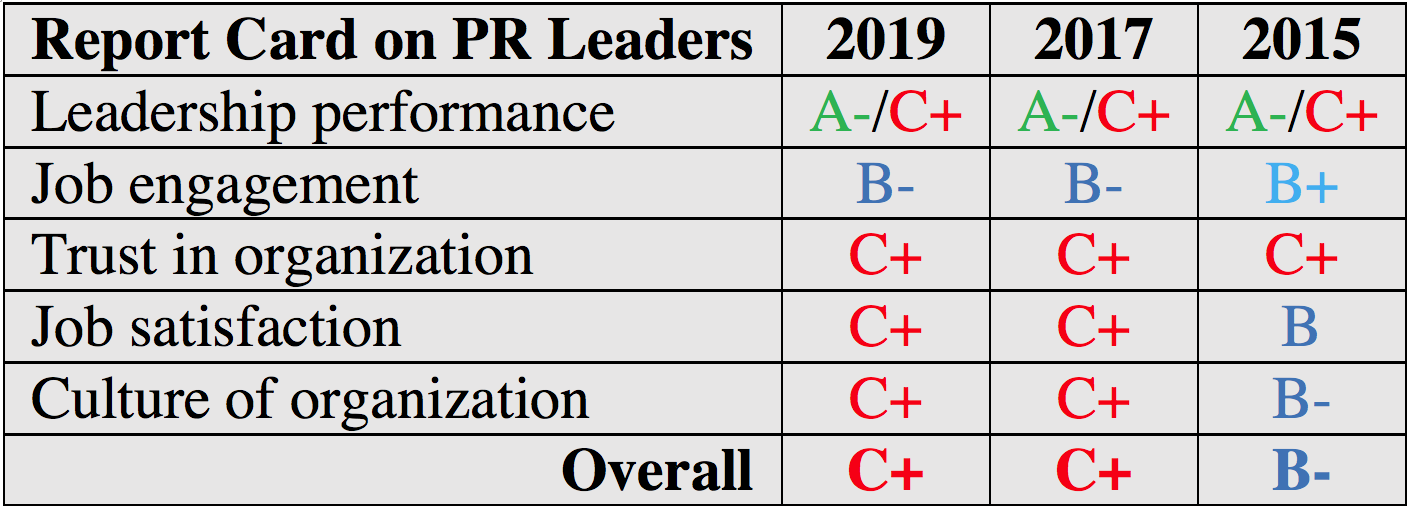Over the last few years, PR leaders have gotten fair to middling grades for their performance from The Plank Center for Leadership in Public Relations. Unfortunately, not much has improved since the industry’s last grading period.
Results of The Plank Center’s Report Card 2019 reflect little change in public relations leadership from studies in 2015 and 2017. PR leaders received an overall grade of “C+” in 2019, similar to previous studies, though down a bit overall in the last five years.
The Report Card 2019 was recently completed with responses from 828 PR leaders and professionals nationwide, who evaluated five fundamental areas of leadership linked to outcomes in the field—organizational culture, quality of leadership performance, trust in the organization, work engagement and job satisfaction. While grades overall were little changed from 2017, job engagement, trust and job satisfaction dropped a bit.
Even more concerning, previously reported gaps in evaluations grew more
- Differences between men’s (45.8 percent) and women’s (54.2 percent) perceptions of the organizational culture and the quality of leadership performance deepened. Similar to Report Card 2017, gaps between top leaders’ (35.1 percent and others’ (64.9 percent) perceptions of all five evaluated areas remained wide.
- Women in public relations remained less engaged, less satisfied with their jobs, less confident in their work cultures, less trusting of their organizations and more critical of top leaders compared to men.
- Previous concerns of both men and women about two-way communication, shared decision-making, diversity and culture were again present.
Is better leadership even on the radar?
The consistently average grades, and the sharp and growing differences among surveyed professionals noted above, beg the question of whether improving leadership is a priority in the profession. Numerous blogs, articles and research studies suggest it is important and needed. However, as Bill Heyman, CEO and president of Heyman Associates, and a co-sponsor of the study, reflected, “Talking about needed changes and improvements in leadership won’t accomplish the change. We need more leaders who live and model the changes.”

The Grades
Public relations leaders again received passing grades for their performance, trust in the organization, job satisfaction and work engagement. Respondents also gave a passing grade to the organizational cultures within which they work. Significant gaps in perceptions between women and men, and leaders and employees, still loom large. Based on the scores, leadership in the field remains pretty average and improvement appears elusive.
Leadership Performance: A-/C+ (2017—A-/C+)
Leadership Performance received a split grade because leaders’ and their employees’ perceptions of performance continue to differ sharply. Top leaders (291 or 35.1 percent) rated their performance (6.09 on a 7.0 scale) about an “A-,” while other employees (537 or 64.9 percent) rated their top leaders’ performance (4.49/7.0) a “C+.” Scores for leadership performance were slightly lower compared to 2017 (6.14 vs. 4.53), but the size of the gap is similar. Leaders often rate their performance higher than their employees do, but the statistical difference here is dramatic.
“The impression about top communication leaders’ performance hasn’t changed nor improved much in the professional communication community, based on results from our three Report Cards,” said Juan Meng, Ph.D., co-investigator and associate professor at University of Georgia, in a news release. “Such consistent but not-so-promising gaps present persuasive evidence that merits serious attention. Improving top communication leaders’ performance shall be a priority. More critically, such changes and actions shall be well communicated to and received by employees in order to close the gaps.”
Job Engagement: B- (2017—B-)
The grade for job engagement remained a “B-“ (5.20 on a 7.0 scale), presenting the same grade since 2017. In Report Card 2019, 59.4 percent of respondents were engaged (vs. 57.2 percent in 2017); 32.6 percent were not engaged (vs 35.9 percent in 2017); and 8.0 percent were actively disengaged (vs. 6.8 percent in 2017). As indicated below, scores for engagement have changed modestly over the past five years:

The more concerning trend reflected in Report Card 2019 is, though percentages are small, the growth of the actively disengaged group among top leaders and especially women. The percentage of actively disengaged top leaders increased from 3.2 percent to 3.8 percent to 5.8 percent in the three surveys. The percentage of actively disengaged women nearly doubled, rising from 5.1 percent to 8.1 percent to 9.6 percent. Meanwhile, the percentage of actively disengaged non-top leaders also gradually grew from 7.2 percent to 8.3 percent to 9.1 percent over the years. Overall, nearly one in 12 professionals (8.0 percent) was actively disengaged.
Trust in the Organization: C+ (2017—C+)
The overall grade for trust in the organization (4.71 on a 7.0 scale) was a “C+,” down a little from a mean score of 4.76 in 2017. Trust has received the lowest grade among the five subject areas in each of the three surveys. Trust scores in 2019 were consistently lower at each level in the chain of command. Top leaders rated trust (5.17) statistically significantly higher than professionals at other levels (4.42). Female professionals (4.55) continued to be much less trusting of their organizations than male professionals (4.90).
Job Satisfaction: C+ (2015—C+)
Job satisfaction was again graded a C+ as it continued a small decline from 4.94 (2015) to 4.76 (2017) to 4.73 in 2019. By percentage, the numbers changed little from 2017. In 2019, the percent of PR leaders and professionals who were satisfied with their job was 62.1 percent (vs. 61.9 percent in 2017); those dissatisfied rose slightly from 24.1 percent (2017) to 24.4percent; and those neither satisfied nor dissatisfied declined from 14.0 percent in 2017 to 13.5 percent. The biggest declines in job satisfaction were among top leaders as their mean scores continued to fall from 5.51 (2015) to 5.31 (2017) to 5.11 in 2019. Job satisfaction is significantly higher for men compared to women (4.87 vs. 4.61). However, mean scores for men and women also continued small declines over three Report Card surveys.
Organizational Culture: C+ (2017—C+)
Overall, organizational culture received a grade of “C+” (4.94 on a 7.0 scale), similar to previous scores of 4.86 in 2017 and 4.95 in 2015. Top leaders rated cultural factors significantly higher (5.29) than professionals at lower levels (4.73). Men rated culture more positively (5.07) than did women (4.83), who rated two-way communication, shared decision-making and diversity significantly lower than men. Women gave shared decision-making one of the lowest scores in the survey (4.08). The biggest gap between women and men lies in the evaluation of organization’s efforts in valuing and practicing diversity and inclusion (4.99 vs. 5.49). Among organizational types, agency professionals rated cultural factors highest (5.59); the group of nonprofit, governmental, educational and political organizations rated culture lowest (4.76).
“Organizational culture is driven by leadership,” said Bryan H. Reber, Ph.D., research director at The Plank Center and professor at University of Georgia, in the release. “It’s rather disheartening that organizational culture remains only ‘average’ and that women give ‘shared decision-making’ such a poor score. Public relations leaders apparently need to back up verbal support of inclusive cultures with more action.”
Three crucial gaps remained wide
Grades for the five areas for leaders remained passing grades in Report Card 2019. Little has changed: leadership in public relations is graded a C+, still pretty average. In addition, three crucial gaps revealed in previous Report Cards remain: 1) different perceptions between top leaders and their employees, 2) deepened gaps between women and men in all five areas, and 3) lack of improvement in building a rich and open communication system, or a culture for communication. The research has clear takeaways for communication leaders, organizations and the profession. Efforts must be dedicated to improve leadership performance. Only effective actions and communication can help reduce and close the gaps. We need to have real changes happening for strengthened leadership, practice and outcomes for the profession and organizations.
“The purpose of this biennial report is to assess leadership in PR and identify enrichment opportunities,” said Bruce K. Berger, Ph.D., co-investigator and professor emeritus at the University of Alabama, in the release. “If we identify the gaps and work to close them, we strengthen our profession’s leadership—a crucial strategic asset. This Report Card underscores the continuing gaps and the urgency to act.”
To download and read the Report Card 2019 full report, visit the Plank Center’s website.
A 41-question survey was distributed online to 22,809 PR leaders and professionals contained within an extensive database, and 861 completed the survey. Thirty-three surveys completed by non-US-based professionals were excluded, leaving 828 complete responses for final data analysis. The response rate provides a 95% confidence level (+/- 5%). Overall, the results represent the larger population of surveyed professionals. Most participants were senior leaders and managers: 74.7% of the 828 respondents were the #1 (35.1%) or #2 (39.6%) communication professional in their organization, and 92.4% had 11 years of experience or more. More women (449 or 54.2%) than men (379 or 45.8%) completed the survey. The majority of participants worked in public (324 or 39.1%) or private (120 or 14.5%) corporations, followed by the category of nonprofits, governmental, educational or political organizations (254 or 30.7%), communication agencies (107 or 12.9%) and self-employed or others (23 or 2.7%).








